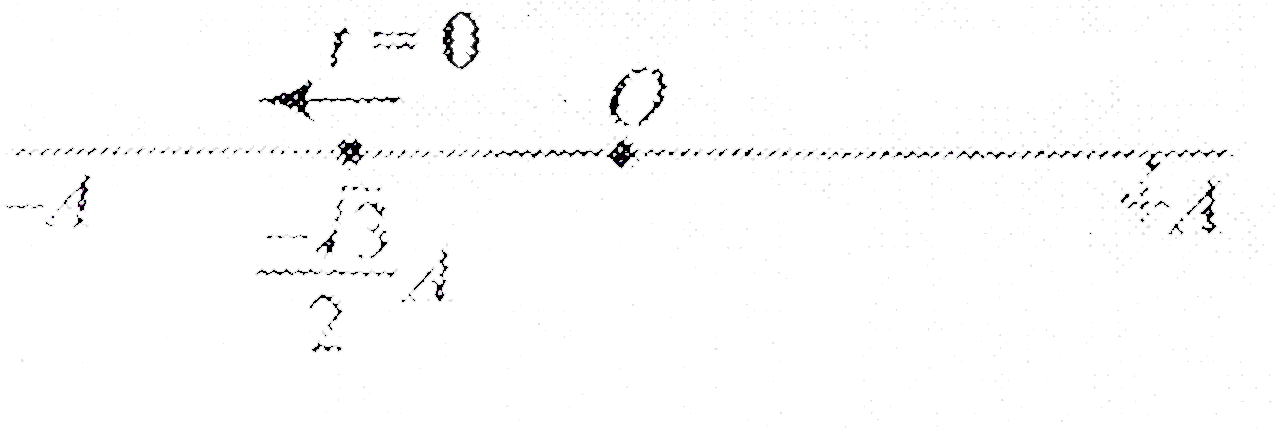Two particles are in SHM along same line. Time period of each is T and amplitude is A. After how much time will they collide if at time t=0. (a) first particle is at x1=+A2 and moving towards positive x - axis and second particle is at x2=−A√2 and moving towards negative x - axis, (b) rest information are same as mentioned in part (a) except that particle first is also moving towards negative x - axis.
The correct Answer is:A, B, D
(a) θ0=ω1t+ω2t

but ω1=ω2=2πT
and θ0=π+π3+π4=1912π
∴19π12=2πTt+2πTt
or t=1948T
(b) θ=2π−θ0=2π−1912π=5π12

Two particles will collide when line XX' becomes the line of bisector of angle θ.
∴ Any one of the particle (say - 2) has rotated an angle
ωt=π/4+θ/2
or 2πTt=π4+5π24=11π24
∴t=11T48
Topper's Solved these Questions
- BOOK - DC PANDEYCHAPTER - SIMPLE HARMONIC MOTIONEXERCISE - Exercise 14.15videos
SIMPLE HARMONIC MOTION
- BOOK - DC PANDEYCHAPTER - SIMPLE HARMONIC MOTIONEXERCISE - Intro. Exer.1videos
SIMPLE HARMONIC MOTION
- BOOK - DC PANDEYCHAPTER - SIMPLE HARMONIC MOTIONEXERCISE - Level 2 Comprehension2videos
SIMPLE HARMONIC MOTION
- BOOK - DC PANDEYCHAPTER - SEMICONDUCTORS AND ELECTRONIC DEVICESEXERCISE - More than One Option is Correct3videos
SEMICONDUCTORS AND ELECTRONIC DEVICES
- BOOK - DC PANDEYCHAPTER - SOLVD PAPERS 2017 NEET, AIIMS & JIPMEREXERCISE - Solved paper 2018(JIPMER)38videos
SOLVD PAPERS 2017 NEET, AIIMS & JIPMER
Similar Questions
A particle is performing SHM with time period T. The time after which KE and PE of particle will be equal is Tx then value of x is: (Consider t = 0 particle is at mean position and U = 0)
View SolutionA particle is performing SHM along x−axis with amplitude 4.0cm and time period 1.2s . What is the minimum time is deci− second taken by the particle to move from x=+2cmto x=+4cm and back again.
View Solution
Knowledge Check
- Question 1 - Select One
Two particles are in SHM along same line with same amplitude A and same time period T. At time t=0, particle 1 is at + A2 and moving towards positive x-axis. At the same time particle 2 is at −A2 and moving towards negative x-axis. Find the timewhen they will collide.
A2T3B5T12C4T3D2T5 - Question 2 - Select One or More
Two particles undergo SHM along the same line with the same time period (T) and equal amplitude (A). At a particular instant one particle is at x=−A and the other is at x = 0. They move in the same direction. They will cross each other at
 At = 4T/3Bt = 3T/8Cx = A/2Dx=A/√2
At = 4T/3Bt = 3T/8Cx = A/2Dx=A/√2 - Question 3 - Select One or More
A particles starts from point x=−√32A and move towards negative extrene as shown . If the time period of oscillation is T , them
 AThe equation of the SHM is x=Asin(2πT+4π3)BThe time taken by the particle tto go directly from its initial position to negative extreme is T12CThe time taken by the particle to reach at mean position is T3DThe equation of the SHM is x=Asin(2πT+π3)
AThe equation of the SHM is x=Asin(2πT+4π3)BThe time taken by the particle tto go directly from its initial position to negative extreme is T12CThe time taken by the particle to reach at mean position is T3DThe equation of the SHM is x=Asin(2πT+π3)
A particle initially at rest starts moving along x-axis.Its acceleration varies with time as a=6tm/s^(2) .If it starts from x=10m .Then the position of particle at t=2s is
View SolutionThe position of particle moving along the x-axis veries with time t as x=6t−t2+4. Find the time-interval during which the particle is moving along the positive x-direction.
View SolutionTwo particles are executing SHM in a straight line. Amplitude A and the time period T of both the particles are equal. At time t=0, one particle is at displacement x1=+A and the other x2=(−A2) and they are approaching towards each other. After what time they across each other? T4
View SolutionTwo particles are in SHM in a straight line about same equilibrium position. Amplitude A and time period T of both the particles are equal. At time t=0, one particle is at displacement y1=+A and the other at y2=−A/2, and they are approaching towards each other. after what time they cross each other?
View SolutionA particle is moving with speed v=b√x along positive x-axis. Calculate the speed of the particle at time t=τ (assume that the particle is at origin at t = 0).
View Solution

